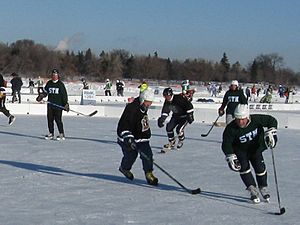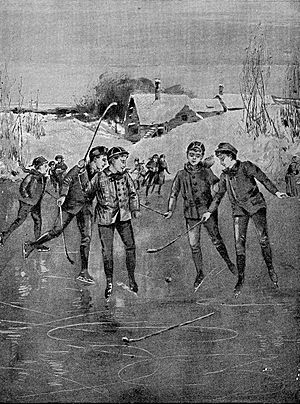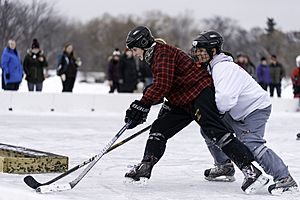Pond hockey facts for kids

A small pond hockey field
|
|
| Nicknames | Ice hockey, Shinny, Pick-up hockey |
|---|---|
| Characteristics | |
| Type | Primarily outdoors |
| Equipment | Required: A ball or a puck (most players use a puck if ice conditions allow, but a ball can be used if the ice has a rough surface), a hockey stick, a net. Optional: Shin pads, gloves, helmet. |
Pond hockey is a fun type of ice hockey. It looks a lot like regular ice hockey, but it's simpler. You play it on a frozen lake or pond. The playing area is smaller than a professional rink. It usually doesn't have tall walls or glass around it. Instead, snow piles often keep the puck in play.
Pond hockey goals are lower than regular hockey goals. They are only a bit taller than a puck. Also, there's usually no special goalie in pond hockey. Because of these differences, pond hockey focuses more on how well you can skate and handle the puck. It's less about powerful shots or hitting other players. When playing just for fun, goals can be anything, and the rink can be any size. Usually, only four players per team are on the ice at one time. But teams can have many substitute players.
There are even big events like the World Pond Hockey Championship. Many other tournaments let players show off their skills. In Canada, "pond hockey" often means any casual outdoor ice hockey. This is usually played on natural frozen water.
Contents
History of Pond Hockey
People played organized outdoor hockey long before indoor rinks became popular. Pond hockey, also called shinny, has old roots. Some stories say it came from early Navajo Native American culture. One Navajo story tells of a stranger who played shinny against a Navajo god. The game was to free Navajo slaves. If the god won, free men would become slaves. If the slaves won, they would be free. A bird helped the stranger win, and the slaves became free.
Shinny was important in many Native American stories. Some stories say the stick or bat looked like clubs used by war gods. People also played shinny to honor their gods. The Cherokees used it to train for war. They called it "little brother of war." It was also played for celebrations. For example, the Makahs of Canada played to celebrate catching a whale. This was a main food source for their tribe in winter.
Almost all tribes played shinny. Women were often allowed to play, sometimes even with or against men. Most of the time, players used one stick or bat to hit the ball. But the Makahs were the only tribe to use two bats. The bats were made of wood. They were thin with a curve and a wider end to hit the ball. Players used their feet to move the ball forward. They could never use their hands.
The balls were made from different things. Some were from a knot in a tree. Others were made of whale bone or buffalo hair covered with deer skin. Balls were made from whatever materials the Native Americans could find. These balls also had interesting patterns. Some tribes in North Dakota were said to be very serious about winning. The distance between goals is not fully known. It is thought they were anywhere from 200 to 1,400 yards (180 to 1,280 meters) apart. They were usually as big as the land allowed. The size also depended on how many players there were. Some stories say the Hopi Indians had fields as long as eight miles (13 km). Their goals reached as far as two villages. Teams were usually even, with up to 500 players on each side. Hockey was first played on a field. Later, it was changed to be played on ice. In some parts of the midwest, like Northbrook, IL, the game is called Puck. People sometimes say, "Let's go tear up the ice!"
How to Play Pond Hockey

Pond hockey is like indoor ice hockey, but it's played outside. Most of the time, it's on a frozen lake or pond. In official pond hockey tournaments, teams usually have four players. But when playing just for fun, there's no set number of players. Players try to make the teams as even as possible.
Sometimes, pond hockey games don't use a goalie. This depends on the equipment available and the players. If there's no goalie, the goals can be anything. They can be regular hockey nets or even players' boots. Pond hockey has become very popular. Official tournaments are now held all over the world. These tournaments have turned casual pick-up games into a serious sport.
The playing area can be any size or shape. But they often look like smaller versions of regular indoor hockey rinks. Some pond hockey rinks use real boards. However, in most games, piled-up snow from clearing the ice works well as a border. In some bigger tournaments, official ice hockey boards are used. For example, the rink at the U.S. Pond Hockey Championship is set up as 155-foot (47 m) long ovals.
Pond Hockey Equipment
Pond hockey usually doesn't involve hard hitting between players. So, the equipment needed is quite simple. Hockey helmets are not required, but many players choose to wear one for safety. Shin pads have also become popular. Most pond hockey players also wear gloves. This is because of the cold weather. Gloves also protect hands from accidental hits from sticks or skates.
Other equipment is the same as basic ice hockey gear. This includes a hockey stick, skates, and a hockey puck. Sometimes, a typical hockey net is used. This depends on if players have one and how close they are to the playing area. But in very casual pond hockey, games are often planned quickly. In these cases, a net might not be used at all. The goal can be defined by almost anything, like clothing or footwear.
Pond Hockey Tactics
The most important skill in pond hockey is good passing. If you make a bad pass, the puck can get lost in the snow around the playing area. Most of the game involves handling the puck in open ice. So, good hand-eye coordination is very important. Speed is also a key quality for a good pond hockey player.
Sometimes, there are no goalies in pond hockey. This means that breakaway shots almost always result in a goal. In pond hockey, a good player doesn't just focus on offense or defense. Teamwork becomes very important. Since there might not be a goalie, or a very skilled one, everyone needs to work together. This helps stop the other team from scoring easy goals. Playing smartly is key. If a player makes a bad pass or falls over, the opponent will have an easy chance to score.
Pond Hockey Rules
The rules of pond hockey are usually like ice hockey rules. But they are often less strict. This depends on the players and how serious the game is. Rules can also change based on how many players there are and what equipment is available. More rules are usually followed in high-level games, like organized tournaments.
Many ice hockey rules are not used in pond hockey. This is because the playing areas are different. Rules like offsides and icing are often not followed. It's hard to enforce them on a pond. Another big difference is that checking (hitting other players) rarely happens. Players don't wear as much padding as they would in regular ice hockey.
Another unique rule in pond hockey is how teams are picked. This usually happens in casual games. Since teams are not usually organized beforehand, they need to be chosen before the game starts. Teams are often picked by chosen captains. Or, they use a method called "drawing sticks" or "sticks in the middle." In this method, all players put their sticks in a pile. One player then splits them into two groups, each with half the sticks. Players whose sticks are in the same group are on the same team.
However, in some organized tournaments, like the Leinenkugel's Classic Pond Hockey event in Wausau, WI, teams are already set up. They are based on regions or schools. One major difference in pond hockey is that all goals are scored from the center. Extra shots are taken from the center of the ice. They should be taken within 30 seconds of a penalty being called. Any player on the opposing team can take the shot. The team that gets the extra shot also gets the puck after the shot attempt, no matter what happens.
Pond Hockey Tournaments
There are many pond hockey tournaments in the United States and Canada. Five of the most well-known are the BC Pond Hockey Series, Canadian National Pond Hockey Championships, U.S. Pond Hockey Championships, the World Pond Hockey Championships, and the Labatt Blue Pond Hockey Tournament.
The BC Pond Hockey Series started in 2009 in Rossland, BC. It now includes tournaments in Prince George, BC and Invermere, BC. The U.S. Pond Hockey Championship has been played on Lake Calhoun and Lake Nokomis. Both lakes are in Minneapolis, Minnesota. There are 116 teams that compete, and each team has four players. Twenty-four sheets of ice are used for the event. Each ice sheet has short boards around it, unlike the tall ones in pro hockey.
The World Pond Hockey Championship is played in Tobique Valley, New Brunswick. It uses 22 sheets of ice for the games. Both tournaments have their own rules for officials, penalties, equipment, and scoring. Anyone can play in these tournaments, no matter their skill level. But because they are so popular, it's important to sign up early. In recent years, these tournaments have become much more popular than expected. News stations have covered them, and they have been in many newspaper headlines. Spectators stand in freezing conditions to watch these games. While the tournaments have rules, their main goal is for everyone to have fun.
The Labatt tournament, in Buffalo, New York, started in January 2008. It has been held every year since. Tournaments like the World Pond Hockey Championships and the U.S. Pond Hockey Championships have made pond hockey popular again. They have brought in many new fans. For example, the Buffalo tournament grew from 32 teams to 124 teams by 2011.
In 2009, the Pond Hockey Classic started in New England. The Pond Hockey Classic now hosts three events. The New England Pond Hockey Classic is in Meredith, NH on Lake Winnipesaukee. It has over 250 teams. The Lake Champlain Pond Hockey Classic is in Colchester, VT on Lake Champlain. It has over 100 teams. The Montana Pond Hockey Classic is in Kalispell, MT. It has over 60 teams. In 2014, the Pond Hockey Classic also took over the Big Apple Pond Hockey Classic, played in NYC at Bryant Park.
See also



